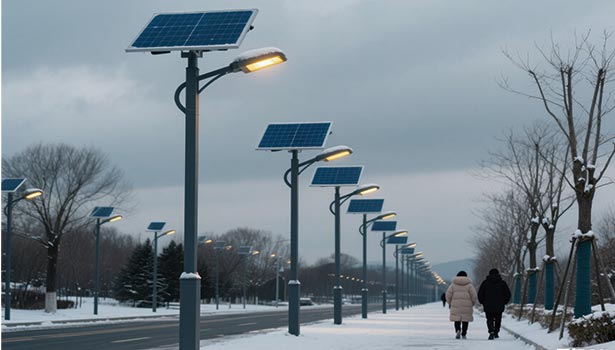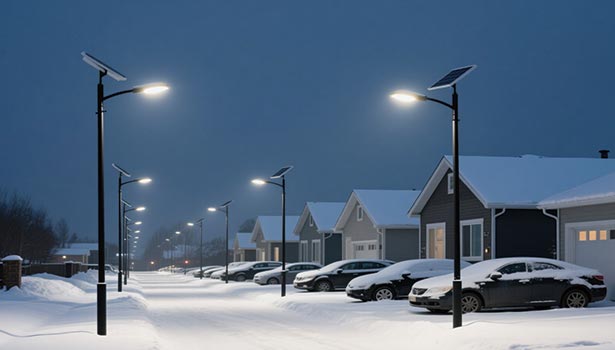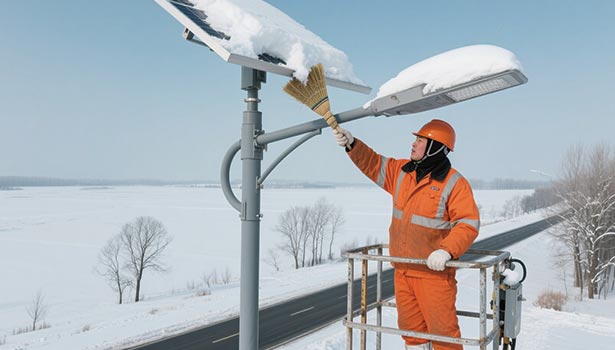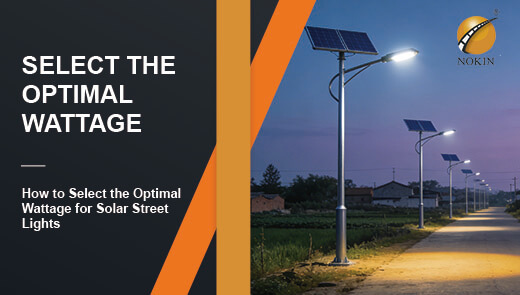Do Solar Street Lights Work in Cold Weather?
In the vast cold regions around the world, many purchasers ask the same question: "Can solar street lights still light up on nights as low as minus 20 degrees Celsius?" In fact, low temperatures are not the "archenemy" of solar street lights. On the contrary, in some cases, the panel efficiency can be higher.
Next, NOKIN will comprehensively answer the question of "winter applicability of solar street lights" from the aspects of power generation principle, temperature limit, component influence, snow treatment to optimization techniques, providing professional references for municipal engineering, park construction, rural renovation and other scenarios, helping you avoid the pitfalls of winter use.

Can Solar Street Lights Work in Cold Weather?
Many people mistakenly believe that "solar energy generates electricity by heating the sun", but in fact, this is a misunderstanding of the principle of photovoltaics. The core power generation component of solar street lights is photovoltaic panels (PV panels), whose working logic is not related to the ambient temperature but only to "ultraviolet rays in sunlight".
From the perspective of the Photovoltaic Effect, the power generation process is divided into three steps:
Photons in sunlight (mainly ultraviolet rays) strike photovoltaic panels.
The electrons inside the panel are "activated" by photons, changing from a stationary state to a moving state.
The moving electrons form an electric current, which is then stored in the battery through the controller.
The entire process does not involve "heat", so even at minus tens of degrees Celsius, as long as there is sufficient direct sunlight, the street lights can generate electricity normally.
Specifically, in terms of usage conditions: High-quality solar street lights only need to receive 6 to 8 hours of direct sunlight each day, and the battery can be fully charged. Subsequently, they can support 4 to 7 days of night lighting. Even if the days are short in winter, as long as the basic duration of sunlight is met, there is no need to worry about battery life.
In a nutshell: Solar street lights can operate normally in cold weather. The temperature does not affect the core logic of power generation; the duration of sunlight exposure is the key.
How Cold Can Affect Solar Powered Street Lights?
"Being able to work" does not mean "working without limit". Different grades of solar street lights have different low-temperature tolerance limits. This is also a core parameter that must be paid attention to when purchasing in cold regions. Based on years of outdoor test data:
Commercial Solar Street Lights:
The lower limit of the effective operating temperature is -20 ℃, which is the standard for most conventional products on the market and can cover most cold regions.
High-end Customized Solar Street Lights:
After adopting low-temperature resistant components, it can operate in an environment of -40 ℃, making it suitable for extremely cold regions.
One more point to understand is that when the temperature drops below the lower limit, it doesn't mean the equipment is damaged; it's just that the battery efficiency will decline. For instance, in an environment of -30 ℃, the battery life of commercial solar street lights may be shortened from 7 days to 5 days, but the LED beads and solar panels themselves will not be damaged by freezing, and their performance will be restored once the temperature rises.
How Cold Weather Influence the Solar Street Lights Components?
The core components of solar street lights are "panels + batteries". The impact of low temperatures on both is completely opposite: the efficiency of the panels will increase, while the batteries need to be selected specifically.
Solar Panel
Many people think that "when it's hot and the sun is strong, solar panels generate more electricity", but in fact, it's quite the opposite - in a low-temperature environment, the power generation efficiency of solar panels will be higher. There are mainly two reasons for this:
More stable crystal structure: The core material of the panel is crystalline silicon. Low temperatures will make the crystal structure more stable, reduce the resistance of electron movement, and increase the efficiency of current transmission.
Snow reflection gain: If the surface of the panel is not completely covered with snow, the reflection effect of the snow on sunlight can enable the panel to absorb an additional 20% or so of light, which is equivalent to "double power generation".
Of course, all of this is predicated on the fact that "the panels are not blocked by snow". Once the snow completely covers the panels, no matter how low the temperature is, power generation cannot be achieved. This is also the core difficulty in the operation and maintenance of solar street lights in winter.
Solar Street Light Battery Type
The battery is the "energy storage warehouse" of solar street lights and also the component that is most prone to problems at low temperatures. The low-temperature performance of different batteries varies greatly, which directly affects the winter endurance of street lights.
|
Battery Type |
Cold Weather Performance |
Minimum Operating Temperature |
Applicable Regions |
|
Lithium-ion Battery (Li-ion) |
Performs well in extremely cold environments |
-40℃ |
Extremely cold regions |
|
Lithium Iron Phosphate Battery (LiFePO4) |
Performs well in generally cold environments |
-20℃ |
Generally cold regions |
|
Lead-acid Battery |
Suitable for mild climates |
-10℃ |
Mild regions |
Based on practical project experience: In cold regions with a temperature of -15 ℃, the battery life of lead-acid batteries is 40% shorter than that at normal temperatures, while that of lithium-ion batteries is only 10% shorter. In cold regions with temperatures as low as -30 ℃, lead-acid batteries may not be able to charge or discharge directly, while lithium-ion batteries can still function normally.
Therefore, when purchasing in cold regions, lithium-ion or lithium iron phosphate batteries must be given priority, and lead-acid batteries should be avoided - even though lead-acid batteries have a lower initial cost, the cost of replacement due to insufficient battery life in the later stage will be higher.

What Should Be Done If the Solar Panels are Covered with Snow?
For cold regions, "snow-covered panels" are a more intractable problem than low temperatures. If not handled properly, it will not only cause the street lights to fail to light up but also may damage the equipment.
3 Risks of Snow Accumulation
Based on over ten years of experience in outdoor projects, the hazards of snow accumulation to solar street lights mainly focus on three points:
Power generation interruption:
Thick snow (over 5cm) will completely block the panel, preventing it from absorbing sunlight, and the battery cannot be charged, causing the street lights to "go black" at night.
Component damage:
During the day, when the snow melts, water can seep into the battery compartment or controller through the gaps in the panel, corroding the circuits and short-circuit equipment.
Premature battery aging:
If snow accumulates for more than three days, the battery will remain in a "undercharged state", disrupting the charge and discharge cycle. A battery that could have been used for five years may need to be replaced after three years.
Solutions to the Snow Cover Problem
For different snow accumulation problems, targeted measures need to be taken, which should not only involve "emergency handling" but also "early prevention".
|
Root Cause of the Problem |
Emergency Solution |
Preventive Plan in Advance |
|
The street light is completely off because the panel is covered with snow |
Use a soft-bristled brush or cotton cloth to clean the snow (do not use an iron shovel to avoid scratching the panel) |
Adjust the panel’s tilt angle to 35°–45° during installation so that snow can slide off naturally |
|
Internal components are damaged by water ingress; snowmelt seeps into panel/battery compartment gaps |
Immediately cut off power, disassemble the casing, dry the moisture, replace the sealing ring |
Choose panels with IP67 or higher protection level and install waterproof rubber strips on the battery compartment |
|
Battery life is significantly shortened due to long-term snow accumulation and discharge |
Use a charger to recharge the battery and restore normal charge/discharge cycle |
Check the battery voltage weekly and clean the panel within 24 hours after snowfall |
Customized Solutions for Solar Street Lights in Snowy Areas
If the project is located in an area with extremely heavy snowfall, relying solely on basic measures is not enough. It is necessary to make "snow resistance preparations" from the design stage:
Optimize the Installation Angle:
Adjust the panel Angle according to the local latitude. For example, in Harbin at 45° north latitude, the panel Angle can be set to 55° (latitude + 10°), and the snow sliding speed will be three times faster than at a 30° Angle.
Site Selection to Avoid Shading:
Before installation, refer to the local winter sunlight data and avoid areas in the shade of buildings and tall trees, such as street lights along the roadside. Ensure that the panels can be directly exposed to sunlight from 9 a.m. to 3 p.m.
Increase the Panel Area:
Within the budget, increase the panel area by an additional 20%. For instance, if the original 100W panel is replaced with a 120W one, even if 20% less electricity is generated in snowy days, it can still meet the battery life requirements.
Install Automatic Snow Removal Devices:
For high-end projects (such as scenic spots and expressways), small electric snow brushes (similar to car wipers) can be installed. They will start automatically after snowfall and do not require manual cleaning.
3 Tips to Make Solar Street Lights Operate Efficiently in Cold Weather
In addition to dealing with snow accumulation, through simple setting adjustments and maintenance, the winter performance of solar street lights can be further enhanced, and the service life of the equipment can be prolonged.
Keep the Solar Panels Clean
Solar panels are the "source of power generation". Even a thin layer of snow or dust can affect power generation. In winter, these two things should be given priority:
Regular cleaning:
Complete the panel cleaning within 24 hours after each snowfall. When there is no snow, wipe the panel once a week to remove dust, fallen leaves and other debris (you can use clean water with a soft cloth, but avoid using cleaning agents).
Prune the surrounding vegetation:
After the trees shed their leaves in winter, prune the branches that may block the panels - for instance, the poplar trees by the roadside. Keep the branches at least 1 meter away from the panels to avoid creating shadows.
Optimize the Solar Street Lights Batteries Performance
Batteries are the "core of energy storage". If batteries are properly maintained in cold weather, their lifespan can be extended by 2 to 3 years.
Give priority to low-temperature resistant batteries:
Clearly state "lithium-ion battery, minimum operating temperature -40 ℃" in the contract when purchasing to avoid suppliers using lead-acid batteries as substitutes.
Battery compartment insulation:
Wrap 5cm thick rock wool insulation (flame-retardant type) around the battery compartment to reduce the impact of low temperatures on the battery - tests show that the battery's endurance can be increased by 15% in an environment of -20 ℃ after insulation.
Regularly check the voltage:
Use a multimeter to measure the battery voltage once a month. The normal voltage should be between 12.5V and 13.5V (for a 12V system). If it is lower than 12V, recharge it in time to avoid power loss.
Adjust the Solar Street Lights Operation Settings
Modern solar street lights all support parameter adjustment. When cold weather comes, you can optimize the operation mode of solar street lights according to your actual needs, minimize energy consumption and extend the usage time as much as possible.
Shorten the lighting duration:
In winter, when it gets dark early and there are fewer pedestrians, the lighting time can be adjusted from "17:00-2:00" (9 hours) to "17:30-23:30" (6 hours), reducing energy consumption by 3 hours per day.
Reduce the brightness level:
For non-main roads, the brightness can be adjusted from 100% to 60%. A 60% brightness can already meet the lighting needs of pedestrians, but energy consumption can be reduced by 40%.
Enable motion sensors:
On sections with less pedestrian traffic, activate the "low brightness + human body sensing" mode. Maintain 30% brightness when no one is around and automatically increase to 100% when pedestrians or vehicles are detected, which can save over 60% of battery power.

If you are choosing solar street lights for projects in cold regions or encounter operational issues with solar street lights in cold weather, you can adjust them according to the plan in this article. For extremely cold regions (such as -40 ℃ environments), NOKIN can also provide customized solutions for solar street lights, including low-temperature resistant components, automatic snow removal devices, dual battery backups, etc., to ensure the stable operation of your solar street lights throughout the year.




